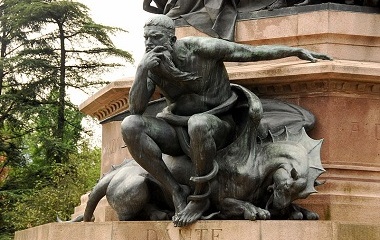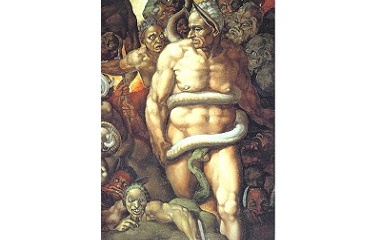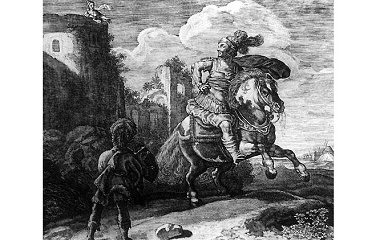- Pronunciation: Mai-nos
- Origin: Greek Mythology
- Role: King of Crete during life, became judge of the dead in the underworld post-death
- Significant Characters: Minotaur, Daedalus, Poseidon
- Parents: Son of Zeus and Europa
- Offspring: Ariadne, Glaucus
- Spouse: Pasiphaë
Who is Minos?
Minos, King of Crete, was one of Zeus’ sons. Despite having an illustrious career in the afterlife as a judge of the fate of damned souls, Minos was controversial to the gods. He shunned the gods after they provided him with a sign for the right to become King of Crete—he most notably ignored the wishes of Poseidon by deciding against sacrificing a stunning white bull which emerged from the sea. This angered Poseidon so much that he made Minos’ wife, Pasiphaë, fall in love with the bull, and her subsequent copulation with the bull led to the birth of Minotaur.
Characteristics
Minos was full of hate and revenge and did everything on his own terms. Minos ignored the wishes of the gods and was also power-hungry and entitled. He was cunning and immensely powerful, but also jealous, revenge-minded and gullible, which ultimately led to his death.
Minos was the son of Zeus and Europa. Minos’ wife, Pasiphaë, gave birth to the Minotaur.
Cultural Representation
Literature
In the poet Homer’s Iliad and Odyssey, Minos was the King of Knossos (the House of the Labyrinth).
Thucydides, an Athenian Historian and General, believed that Minos was the first man to have a navy.
In the Aeneid of Virgil, Minos was the decider of the fates of those who were given the death penalty based on an incorrect charge. Minos, one of the three judges of death, is atop a huge urn and he chooses the destination of the soul—along with a soundless jury—to either Elysium or Tartarus.
In Inferno, the epic poem by Dante, as part of his Divine Comedy, Mino sits in the Second Circle of Hell, where souls are placed on trial as they admit to their sins. Mino is portrayed with a gigantic tail sprouting from behind him which is reminiscent of a snake and—to decide the correct level of punishment for these souls—he wraps his tail around himself. The number of times Minos’ tail wraps around him shows in which Circle the fallen soul will spend eternity. Once his tail finishes wrapping around his body, he vocally tells the soul which Circle he is confined to.
In The Battle of the Labyrinth, the fourth part of Rick Riordan’s books from the Percy Jackson series, Minos is shown to be assisting the demigod Nico di Angelo as he tries to bring his sister back to life. However, in this book, Minos only wanted to help Nico di Angelo because he wanted to deceive him into murdering Daedalus, the man who built the labyrinth. He wanted to do this because Daedalus was the only person who knew how to escape its clutches, and the only person who understood how to kill the Minotaur.
Minos and the Minotaur appear in the book In the Grip of the Minotaur, authored by Farnham Bishop and Arthur Brodeur.
In the postmodern and experimental novel House of Leaves, Minos and the Minotaur are written about several times in the fictional manuscript that comprises a significant part of the novel by the deceased character, Zampanó. In Zampanó’s discussion, he draws comparisons between the mythological Ancient Greek labyrinth and the house’s labyrinth in his novel. Zampanó depicts the Greek mythological labyrinth in a perplexing mixture of accurate and inaccurate ways.
In Mary Renault’s The King Must Die, Minos is infected with leprosy and wears a symbolic mask of a bull. This story explores his illicit stepson, who is nicknamed The Minotaur.
Visual Arts
In the Sistine Chapel—and in reference to Dante’s Inferno—Michelangelo’s renowned painting The Last Judgement depicts Minos as the judge of the underworld, encircled by various devils. His tail is wrapped around himself, and sprouting from the side of his head are donkey ears (connoting foolishness). Minos is shown deciding the fate of the souls who are put in front of him for trial to hell.
Coin and Vases
On Cretan coins, Minos is represented as bearded, wearing a type of crown known as a diadem, a headband which connotes royalty. Minos has curly hair and appears arrogant and honorable. He is portrayed in a similar manner to Zeus due to their blood relations.
On painted vases and sarcophagus bas-reliefs he frequently occurs with Aeacus and Rhadamanthus as a judge of the underworld and in connection with the Minotaur and Theseus.
Explanation of the Myth
Asterion, the King of Crete before Minos, originally adopted three sons from Zeus and Europa: Minos, Sarpedon and Rhadamanthus. Asterion allegedly received all the laws straight from Zeus. Minos’ son, Androgeos—after winning the Panathenaic games—was sent by the king, Aegeus, to Marathon to combat a bull. However, Androgeos lost the bull-fight, and subsequently died. This enraged Minos, and he traveled to Athens to avenge his son. On his travels there, he camped in the territory in which Nisus—the King of Megara—lived. Minos discovered that Nisus’ strength came from his crimson hair, which was buried amongst the white, and subsequently got his daughter—Scylla—to fall in love with him. After obtaining Scylla’s love, Minos convinced her to cut off her father’s hair so that he could conquer Megara. Once Minos conquered the city, he punished Scylla for her lack of loyalty, tying her to a boat which dragged her about until she finally drowned. Once Nisus got to Attica, he asked Zeus to penalize the city. Zeus obliged, and ravished the city with plague and famine. Worried, an oracle instructed the Athenians to comply with whatever Minos wanted in order to escape a wretched fate.
Minos demanded that, every nine years, King Aegeus—the founder of Athens in Greek mythology—pick seven young girls and seven young boys to go to the labyrinth in Crete—Daedalus’ creation—to be consumed by the Minotaur. Eventually, the minotaur was defeated by the hero Theseus with the assistance of Minos’ daughter, Ariadne.
Eventually, Minos ascended as King. He said that he had prayed to Poseidon for a sign and he provided him with one, by sending a colossal white bull from the sea. Minos was meant to sacrifice the bull as a way of thanking Poseidon. However, Minos decided to sacrifice a different bull. This infuriated Poseidon and he cursed Minos’ wife, Pasiphaë, which caused her to fall in love with the bull. Daedalus constructed a wooden cow for Pasiphaë, so that she could hide inside it. The bull copulated with the wooden cow and impregnated Pasiphaë, which caused her to give birth to the abomination that was called Asterius. This was the part-man part-bull Minotaur. With his pride injured, Minos did not want anyone to find out who the Minotaur was and did not want anyone to know how to escape from the labyrinth. The only person who knew who he was and how to escape was the labyrinth’s constructor, Daedalus, along with his son, Icarus. Though Daedalus was able to escape with Icarus as he had fashioned wings for him, Icarus flew too close to the sun and his wings melted, causing him to fall and drown in the sea.
Death of Minos
As Daedalus escaped from the labyrinth, Minos went to hunt for him. He travelled everywhere to search for him. Minos went to each city to ask a riddle. He reached Camicus in Sicily, where he asked King Cocalus the riddle. After that, the king was confident that Daedalus would be able to solve the riddle presented by Minos. The riddle Minos asked was about a spiral seashell that needed to be strung all the way through. Daedalus tied the piece of string to an ant, which travelled through the seashell. Minos knew that Daedalus was in King Cocalus’ court and he commanded that Daedalus be handed over to him. However, the king offered Minos a bath first. After Minos accepted the offer, he became trapped in the bath and—along with the king’s daughters—Daedalus poured boiling water onto him until he died.
After he died, Minos became a judge of the dead for Hades. He worked alongside Aeacus and Rhadmanthus. The former judged Europeans and the latter judged Asians. Minos held the cards, as he casted the deciding vote on the fates of the dead.










